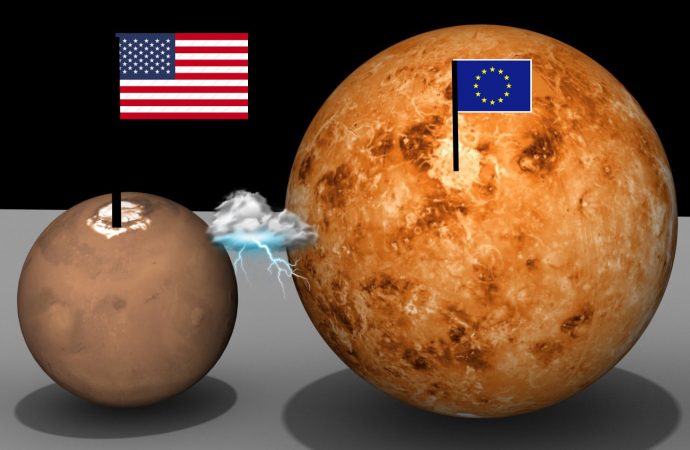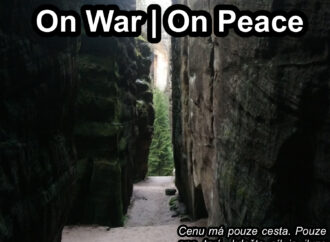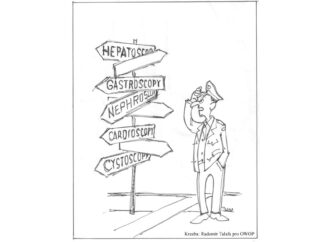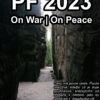Author of this text Martin Svárovský is a historian and diplomat. He is currently working on Czech Ministry of Foreign Affairs. The opinions expressed in this article are the author’s own and do not reflect the view of the Czech ministry of Foreign affairs.
The new National Security Strategy of the USA, published in December 2017, represents a significant shift in the US strategic thinking and policymaking. The adversaries, rather than terrorism are the center of the NSS attention and the US is openly declaring a resolve to approach them from the position of strength. The new strategy also states that the US will rethink the policy of engagement with rivals. (Not only was the “engagement” a part of the US policy of the previous administration, it is also at the core of political or military doctrines of the most of European states.) Another remarkable characteristic of the NSS is that US does not see military force just as an instrument of urgent crisis management. It attaches a significant role in pursuing the American national interest to the military.
At the same time, the wording of the NSS, as well as of other partial strategies, such as the new US defense strategy, the new US Iran Strategy or the new US nuclear posture clearly indicate that the US will seek to cooperate with partners while handling different security issues from the position of strength. All these doctrinal documents identify Europe as a key partner. Therefore we, as Europeans, do not only need a thorough analysis of these documents but also a frank political debate to determine whether this trend in the US foreign policy represents an opportunity for us or not.
It is common knowledge that American and European perspectives on the topic of the use of force are diverging. As a former advisor to Senator John McCain and one of the leading US intellectuals Robert Kagan put it: „Americans are from Mars and Europeans are from Venus“. Even though there is a big difference between the US and EU in their willingness to use military force, it is a fact that the European Union is not a “paper tiger” any longer.
Europe is a superpower in terms of its economic strength and global attractiveness of the European way of life and its values. The main thesis of this article is, that if EU wants to play an important role in global arena, it needs to pay attention to the two following issues: First, the efficiency of the money and effort devoted to its military capability and second, the EU´s ability to play a complementary role to its priority partners on the global arena, i.e. the North Atlantic Alliance, the United states and the UN (Apart from the US, the Alliance and the UN and the OSCE or regional groupings like the African Union belong to the security providers and potential partners of EU. Nevertheless I believe the main partners are actually the Alliance and the US.). What is needed for achieving such a complementarity is, among others, an enhanced strategic US-EU dialog that can bring more EU-US compatible security-strategic “narrative”.
Among the “new” members of the EU and the NATO, who are questioning the meaning of European security and defence policy because of their “NATO first” approach, more awareness is needed that there is no strict contradiction between territorial defence and the crisis management. The crisis management can be perceived as a kind of “forwarded” territorial defence (and of a continuum of efforts to promote a rules-based international order).
CSDP Crisis Management
The last couple of years have been characterized by significant rise of EU security and strategic ambitions as well as by a vibrant security environment in areas adjacent to Europe. This led to the unprecedented amount of money and effort given to the security/military dimension of the EU policy. The EU adopted its “Global Strategy” (EGS) which serves as a basic doctrinal document in the field of security and defense. The EGS brings new initiatives like the Permanent Structured Cooperation (PESCO), the Coordinated Annual Review on Defence (CARD) or the European Defence Fund (EDF) and represents in fact a whole complex of issues and policies. This automatically brings the necessity of the comprehensive political debate on efficient usage of wide range of EU external policy instruments, including those covered by the by the Common Security and Defense Policy (CSDP).
This article is to focus “only” on one specific aspect of the CSDP that is Europe´s ability to project power abroad. As for the number of troops deployed on missions, the EU is rather a modest security player. There are 10 civilian Missions and 6 military Missions and Operations within CSDP with some 2,000 civilians and 3,300 military staff deployed in Europe, in the Middle East, and in Africa. Nevertheless, one has to add to it that the EU frequently plays a role of a “force multiplier” for worldwide crisis management and the data on entire European military capability are quite impressive. Within the EU there are half million troops combined and 200 billion Euro are spent annually in defense. This does not correspond to the achieved output in the field of “power projection” It leads to a conclusion that, besides the political debate on the shape of the CSDP, its crisis management system requires some structural improvements as well. First and foremost, it is about enhancing the structure of command and control as well as about strengthening synergy between the civilian and military component of the system.
The EU needs a full-fledged operational headquarters that would be able to plan and conduct the EU CSDP military missions. Later, the EU might even think of establishment of permanent structure that would combine the civilian and military components and would be responsible for planning and conducting of all CSDP missions. So far, the EU has such structure on strategic level just for civilian missions – the Civilian Planning and Conduct Capability (CPCC). As for the military missions, there is only a sort of embryo in a form of the Military Planning and Conduct Capability (MPCC). It consists of 40 people and is “only” responsible for conducting three non-executive training missions in Africa. (Executive” operations are operations mandated to conduct actions on behalf of the host nation; “non-executive” missions are operations that support the host nation with an advisory role only.) The head of the MPCC is called a “director” not a “commander”.
Let us look at two practical examples demonstrating the meaning of weak command and control structure and underdeveloped civilian military synergy.
The problem in the field of planning is that already at the very early preparatory stage for the mission, i.e. at the moment when we are on the margin between conflict analysis and planning of the mission, it is necessary to decide whether the EU will deploy a civilian or a military mission. This puts limits on the work of the EU planners since a real crisis is a complex situation with a wide range of different factors. Some of them require police solution and some of them military one. Then, after basic strategic political documents (Political Framework for Crisis Approach and Crisis Management Concept) are prepared and after the (Foreign Affairs) Council decides on the establishment /not yet launch/ of a mission, the planning process is completely split into two parallel tracks- the civilian or the military one – according to the type of the mission.
In the field of command and control we are facing slightly schizophrenic situations in particular cases. It occurs that in one single theatre (like Somalia) there are two EU missions that have entirely different „chain of command“. Moreover, in the particular case of non-executive missions, the absence of the military strategic level of command may inherently weaken these missions by depriving them of Brussels-based strategic guidance, especially when those missions have been militarily challenged (such as the mission in Mali, 2016).
One can conclude that enhancing synergy between civilian and military component in the full spectrum of the CSDP crisis management really makes sense. On the other hand, the full integration is not an option either. First, because of the legal and financial difference between Military Operations and Civilian Missions and second because the capability of the EU to deploy either civilian or a military mission can contribute to its ability to work in complementarity with other security providers (NATO, USA, etc.). In other words, the EU can possibly adjust the nature of its crisis-response according the scope and shape of the forces deployed by the other security providers.
Overcoming a sharp civilian-military dichotomy and applying a similar approach as to the foreign missions of the United States or the United Nations would require substantial political-strategic debate on EU security doctrine as well as changes in the CSDP architecture (first and foremost the establishment of the EU operational headquarters). Maybe this is the reason why the EU strives to support civ-mil synergy step by step. Intensive conceptual work has started in some specific segments of the CSDP. It concerns issues like sharing logistic intelligence, synergy in the strategic lift, medical support or operation infrastructure. Further issues where intensified cooperation between civilian and military component of CSDP is conceivable represent force protection, IT, sharing of premises or better use of the Joint Support Coordination Cell which is formed by the MPCC and CPCC together.
It is fair to say that the EU crisis management system has also comparative advantages to other security providers. What is definitely unique on the EU crisis management, is the so-called “Integrated Approach” (IA), and the EU emphasis on sustainability. The IA, a principle that was adopted by the Foreign Affairs Council in January this year, intensifies the linkage between the CSDP and the “Justice and Home Affairs” field as well as between CSDP and the Development Cooperation. The linkage concerns both, the conceptual setting as well as the synchronization of different tools and instruments of the EU. Moreover, the IA also put emphasis on the “early warning system” and on a thorough conflict analysis covering a variety of aspects of the crisis. What is important is the fact that the early warning system should be more inclusive to provide a space for the member states’ knowledge – intelligence as well as the expertise of national Embassies from the spot. One of the declared priorities under IA is also active cooperation with civil society in preparatory as well as implementation phase of the missions. All this creates an opportunity for specific know-how of countries like the Czech Republic.
The case of Iraq can serve as a test of the above-mentioned complementarity. In this country, the EU will be in the same theatre with other major security providers. The EU, at the very beginning of the planning of the Iraqi CSDP civilian advisory mission took the complementarity very seriously. One of the three basic operation lines of the mission is „strategic coordination and cooperation“.
Potential is there and what more?
All this leads to the conclusion that despite the structural weaknesses and constrains, limited scope of forces in relation to the US or the UN, quite new military identity compared to NATO, the EU is able to play a role of a global security provider. Nevertheless, necessary reforms still require political will as well as a new political-strategic narrative. A narrative reflects the character of the state and its people. In this light, the US and the EU narrative will be always different.
In my opinion, the system that provides any entity with the capability to deploy forces abroad should be justified by three main grounds: 1. Helping people in need. 2. “Forwarded defense” of such entity. 3. Last but not least, strengthening the influence of the entity in countries of deployment. There is no reason to hide any of the three grounds. This open, straightforward narrative might be regarded as politically sensitive. On the other hand, an open acknowledgment of the “influence phenomenon” and clear identification of benefits stemming from the deployed missions would help to generate necessary political will. In this regard the American political-strategic narrative can be inspiring for Europe.
It is worth mentioning that both Chairman of the European Union Military Committee and Head of European Security and Defence College in their common letter to HR/VP speak openly about creating common strategic culture and military identity within the EU not only as a value in itself but also to reinforce complementarity with the civilian dimension and tools. This certainly is a step in the right direction.
Targeted civilian and military actions
The expenditure for EU’s actions at international level (the chapter of the budget called “Global Europe”) still represent less than 10% of entire EU budget. At the same time there is a tendency to increase the amount of money for the CSDP in the future. The majority of member states are in favor of more strategic approach toward specific regions and in favor of a more strategic approach to the spending within CSDP.
The European Union, according to its foreign minister Mogherini wants to be seen as a global security provider. This was also the dominant message of the recent Munich Security Conference. The German foreign minister said it bluntly:
If Europe wants to have an influence in the world it must have a partner. Therefore, the cooperation with the United States and the NATO is of paramount importance. Europe needs to have the ability to project power in the world.
President of the European Commission Jean Claude Juncker underlined the necessity of the EU military emancipation. This emancipation, according to him, must not concur but be complementary with NATO.
The European approach to security and defence lies precisely in the unique mix between targeted civilian and military actions: this is what makes the European Union such a unique security player in the world. At the same time, a sharp division line between civilian and military missions, especially in terms of planning and conduct, pose a number of practical limits. More civilian-military synergy is needed to increase efficiency of the entire system of CDSP crisis management.
My central point is that the EU has tangible potential of playing complementary role to the NATO and the United states. (The EU has developed the framework for cooperation with the NATO, the USA as well as the United Nations. In all three cases it concerns concrete practical steps on the ground as well as conceptual documents defining such a cooperation.) There will be always significant difference between the USA, the Alliance and the EU given the fact the different character and setting of this entities.
Europe is not a single state. Some divergence between Southern and Northeastern wing of the EU when it comes to the threat assessment and the territorial focus of the CSDP crisis management will always be present. Nevertheless, despite this divergence, the need of structural reforms that would increase both efficiency of CSDP and its complementary character to other security providers is a matter of consensus. In addition to structural reforms, more trans-Atlantic strategic dialogue is needed. It concerns not only crisis management conduct but also the pre-conflict state – specifically collaboration on conflict prevention and the mission planning. The Interoperability of the EU and the US (or the Alliance) assessment and planning tools should be explored.
What about the Czech Republic within this context? In the Czech Republic´s interest is the efficiency and coherence of the EU Common Foreign and Security Policy. This concerns also CSDP as an integral part of it. Complementarity of CSDP with NATO and the US should clearly remain a priority for the Czech Republic, which regards the Alliance as the core of its security guarantee. At the same time, the Czech Republic needs to do as much as it possibly can so that the regions like Eastern Europe and the Balkans remain high on the EU agenda. (The EU´s attention is now focused on other regions – see current geographical scope of the deployment. Moreover, new projects are planned in Mali, Central African Republic, Syria, Palestine, Somalia, G5 Sahel or South Asia). The rich institutional architecture of CSDP provides the Czech Republic with the opportunity (and the need as well) to offer and place its experts in analytical and planning crisis management bodies. This is a topical issue, especially in the light of British experts´s withdrawal due to the Brexit.
Europe, from the outset of its integration, was not supposed to be a global power. Instead, it was a project aimed at internal reconciliation. However, in today’s world characterized by a large scale of interdependency, EU cannot do otherwise but become a global security provider.











Leave a Comment
Your email address will not be published. Required fields are marked with *